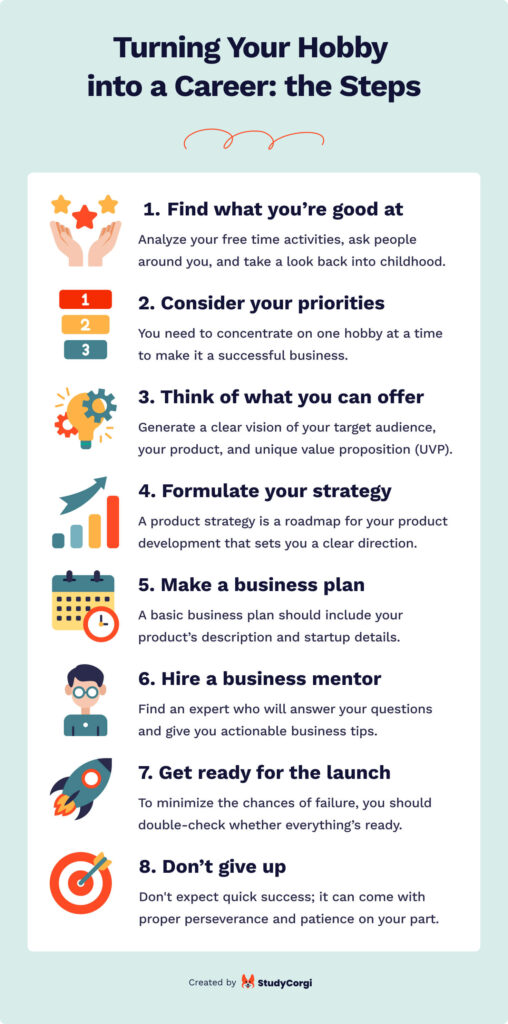Are you passionate about your hobbies and dream of turning them into a profitable business venture? Look no further! In this article, we will be guiding you through the steps of transforming your crafting skills into a lucrative side hustle. Whether it’s painting, knitting, or woodworking, we’ve got you covered with valuable tips and insights to help you monetize your talents. Get ready to take your hobby to the next level and start generating income doing what you love. It’s time to turn your passion into a thriving business!

1. Identifying a Profitable Hobby
One of the first steps in turning your hobby into a profitable business is to identify a hobby that has the potential to generate income. Take a look at the activities you enjoy and have a talent for – this could be anything from painting, knitting, baking, or even gardening. The key is to choose a hobby that you are passionate about and have a natural inclination towards.
Consider what sets your hobby apart from others. Are you particularly skilled at it or have a unique style? Is there a demand for products or services related to your hobby? Evaluate the market for your chosen hobby by researching online communities, social media groups, and local markets to gauge the level of interest and potential profitability.
2. Market Research and Analysis
Once you have identified a potentially profitable hobby, it’s time to dive into market research and analysis. This step is crucial to understanding your target audience, identifying your competition, and uncovering any gaps in the market that you can fill with your products or services.
Start by researching your target audience – who are they, what are their preferences, and what kind of products or services are they already purchasing? This will help you tailor your offerings to meet their specific needs and stand out from the competition.
Next, analyze your competition. Look for similar businesses or individuals who are already offering similar products or services in your niche. Study their pricing, marketing strategies, and customer reviews to gain insights into what works and what doesn’t. This will allow you to position yourself effectively in the market.

3. Creating a Business Plan
A well-thought-out business plan is essential for any successful venture. It serves as a roadmap for your business and provides a clear direction for achieving your goals. To create an effective business plan, consider the following elements:
Mission and Vision Statement
Clearly define the purpose and vision of your business. What do you aim to achieve and how do you want to make an impact in the market?
Target Market Analysis
Identify your target audience and understand their needs, preferences, and buying behavior. This will help you tailor your products or services to meet their specific requirements.
Products or Services
Outline the details of your offerings – what products or services will you provide, and how will they fulfill the needs of your target market?
Marketing and Sales Strategy
Develop a comprehensive marketing and sales strategy to promote your business and attract customers. Outline the channels you will use, such as social media, websites, or local markets, and detail your pricing and pricing strategies.
Financial Projections
Estimate the costs involved in setting up and running your business. Calculate your expected revenue, expenses, and profit margins to ensure that your hobby can generate a sustainable income.
Implementation Plan
Create a step-by-step plan for implementing your business strategies and achieving your goals. Set clear milestones and deadlines to keep yourself accountable and measure your progress.
4. Legal Considerations
As you start turning your hobby into a business, it’s crucial to consider the legal aspects to ensure compliance and protect yourself and your business. Here are some legal considerations to keep in mind:
Business Structure
Decide on the legal structure of your business – whether you want to operate as a sole proprietorship, partnership, limited liability company (LLC), or corporation. Each structure has different legal and tax implications, so it’s essential to research and consult with a professional to determine the best option for you.
Licenses and Permits
Research the licenses and permits required to legally operate your business. This may include local business permits, health permits, or specialized licenses depending on the nature of your business and location. Make sure to obtain all necessary permits to avoid legal issues down the line.
Intellectual Property Protection
Consider trademarking or copyrighting your unique brand or products to protect them from infringement. Consult with an intellectual property attorney to determine the best course of action for securing your intellectual property rights.
Tax Obligations
Understand the tax obligations associated with running a business. Familiarize yourself with federal, state, and local tax requirements, and consider consulting with an accountant to ensure compliance and optimize your financials.

5. Financial Planning and Funding
Financial planning plays a crucial role in the success of your business. Careful consideration of your costs, pricing strategies, and funding options is essential. Here are some aspects to consider:
Cost Analysis
Identify all the costs involved in setting up and operating your business. This may include equipment, supplies, workspace rental, marketing expenses, packaging materials, and more. A thorough cost analysis will help you determine your pricing strategy and ensure that your business is financially viable.
Pricing Strategies
Determine how to price your products or services to cover costs and generate desired profits. Consider the cost of materials, labor, overheads, and desired profit margins. Research the market to ensure your pricing is competitive while still allowing for profitability.
Funding Options
Evaluate your funding options based on your financial needs and goals. This could include self-funding using your savings, securing loans from banks or credit unions, or exploring grants, crowdfunding platforms, or angel investors. Choose the option that best aligns with your business requirements and financial capabilities.
Financial Management
Implement good financial practices, such as regularly tracking your income and expenses, setting aside funds for taxes and emergencies, and monitoring your cash flow. Consider using accounting software to streamline your financial management and provide accurate records for tax purposes.
6. Establishing Your Brand
Establishing a strong brand is crucial for the success of your business. Your brand is what sets you apart from your competitors and helps customers identify and connect with your products or services. Here’s how you can establish your brand:
Brand Identity
Create a cohesive and visually appealing brand identity that represents your business and resonates with your target audience. This includes designing a logo, selecting fonts and colors, and creating a consistent visual style across all your marketing materials.
Brand Messaging
Develop your brand’s messaging, including a compelling brand story and key messages that communicate the value your products or services offer to customers. Ensure that your messaging reflects your brand’s personality and values.
Online Presence
Build a strong online presence through a well-designed website and active social media profiles. Showcase your products or services, engage with your audience, and share valuable content that positions you as an expert in your field.
Customer Experience
Deliver exceptional customer service and ensure a positive customer experience at every touchpoint. This includes providing prompt responses to inquiries, offering personalized recommendations, and going above and beyond to exceed customer expectations.

7. Product Development and Pricing
Once you have established your brand, it’s time to focus on developing your products or services and determining the right pricing strategies. This involves careful consideration of product development, quality control, and competitive pricing. Here’s how you can approach this stage:
Product Development
Refine your skills and invest time in creating high-quality products or services that align with your target audience’s preferences. Continuously seek feedback from your customers and adapt your offerings based on their needs and preferences.
Quality Control
Maintain strict quality control measures to ensure that your products or services meet the highest standards. Pay attention to every detail, from sourcing the right materials to implementing rigorous quality checks.
Competitive Pricing
Research and analyze the pricing strategies of your competitors to ensure that your pricing is competitive while still allowing for profitability. Consider factors like cost of materials, production time, labor, and desired profit margins. Test different pricing strategies and adjust as necessary based on market demand and customer feedback.
Value-Added Services
Consider offering value-added services to enhance your offerings and differentiate yourself from competitors. This could include personalized packaging, customizations, or additional services that provide convenience or added value to customers.
8. Marketing and Promotion Strategies
Marketing and promotion play a crucial role in attracting customers and generating sales. In this digital age, it’s essential to leverage various marketing channels and strategies to reach your target audience effectively. Here are some effective marketing and promotion strategies for your business:
Social Media Marketing
Create social media profiles on platforms that are popular among your target audience. Develop a content strategy that includes engaging posts, videos, and relevant information that showcases your products or services. Actively engage with your audience to build relationships and increase brand awareness.
Website and SEO
Build a user-friendly website that showcases your products or services, provides valuable content, and enables customers to make purchases or inquiries easily. Optimize your website using search engine optimization (SEO) techniques to improve your online visibility and attract organic traffic.
Email Marketing
Collect email addresses from customers and potential customers and create a mailing list. Send regular newsletters or promotional emails to keep your audience engaged and informed about new products, special offers, or upcoming events.
Influencer Marketing
Collaborate with influencers or bloggers in your niche to promote your products or services. Identify influencers who align with your brand values and have an engaged audience. This can help increase brand awareness and drive sales.
Local Marketing
Participate in local markets, craft fairs, or community events to showcase your products or services. Offer special discounts or incentives to attract customers and build a loyal local customer base.

9. Selling Your Products
To generate revenue from your hobby-turned-business, it’s essential to establish effective sales channels and strategies. Here are some options to consider:
E-commerce Platforms
Set up an online store on popular e-commerce platforms like Etsy, Shopify, or Amazon. Leverage the built-in audience of these platforms to reach a wider customer base and make it easy for customers to discover and purchase your products.
Local Boutiques and Stores
Approach local boutiques, gift shops, or specialty stores that align with your brand to stock your products. Develop a compelling pitch and offer them a wholesale price or consignment arrangement. This can help expand your reach and attract customers who may not have discovered your products online.
Direct Sales
Participate in craft shows, trade fairs, or health and wellness events to showcase and sell your products directly to customers. Engage with potential customers, offer demonstrations, and provide a personalized shopping experience.
Collaborations and Partnerships
Collaborate with complementary businesses or professionals to cross-promote or bundle your products or services. This can expose your brand to new audiences and create mutually beneficial partnerships.
10. Managing Your Business and Scaling Up
Managing your business effectively is crucial for long-term success and growth. Here are some tips for effectively managing and scaling up your business:
Streamline Operations
Continuously review and optimize your business processes to increase efficiency and productivity. This may involve outsourcing certain tasks, investing in software or tools to automate processes, or improving communication and collaboration within your team.
Customer Relationship Management
Maintain a strong relationship with your customers by providing exceptional customer service, addressing their concerns promptly, and seeking feedback for continuous improvement. Cultivate a loyal customer base by implementing loyalty programs or offering exclusive perks.
Expansion and Diversification
Consider expanding your product line or diversifying your services based on market demand and customer feedback. Continuously monitor trends and changes in the market to stay ahead of the competition and capitalize on new opportunities.
Seek Professional Guidance
As your business grows, consider seeking professional guidance from consultants, mentors, or business coaches who can provide valuable insights and strategies to help you navigate challenges and facilitate growth.
Continuous Learning
Stay updated with industry trends, new techniques, and innovations in your field. Invest in professional development courses, attend workshops or conferences, and network with fellow entrepreneurs to stay informed and inspired.
By following these steps and continuously adapting to market trends and customer feedback, you can turn your hobby into a profitable business. Remember to stay passionate, committed, and open to learning, and you’ll be well on your way to success. Good luck!


